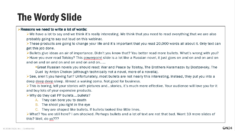Summer Reading: The Five Elements of Webinar Storytelling
B2B WebinarsFor the next summer series playlist track , we’re going to put on the ritz. Jazz it up a little. Add some flair to the webinar air. We’re going to talk, of course, about generating great webinar stories.
So, how can you add some glitz to your webinar story glamor? Simple: organize. Plot, plan and then push your content. Getting the elements of your story right is critical because, as Mark Bornstein notes in “10 Secrets for Creating Great Webinar Content ,” webinars are getting longer — up to 56 minutes on average in 2017. That added length means you have an exceptional opportunity to draw your audience in and push great content out.
So, where to start? Well, right here:
1. Have a goal in mind.
First, you need to have a goal for your specific webinar. This is where having detailed ideal customer profiles, personas and buying cycles in place helps. By knowing where your proposed webinar is going to fall across those three elements, you can select, craft or recycle highly relevant content that benefits the audience your aiming to address. Consider this the plotting stage of your webinar story.
2. Find inspiration in content that works
Your organization has stories. It has content. It has material you can take and turn into a webinar. For example, it has content for top, bottom, and middle-of-funnel buyers. Find the material that performs best — whether it’s a white paper, ebook, case study, research or just a blog post — and use it as inspiration for your webinars. Break your selected content down into topic areas and build out webinars based on those topics.
3. Refine
Once you have a topic selected — one that solves a problem for your audience — it’s time to refine. By refining, we mean focusing your webinar entirely on one subject and one subject only. Refrain from asides. Don’t try to connect one subject to another. Just focus on the topic you chose. By going deep into one issue, you’ll provide your audience with tangible benefits and prove your expertise.
4. Build your story
Finally, it’s time to build your story. This is where you get to add the neat little details. It’s hard, sure, but the good news is most of the heavy lifting is already done. You have an audience in mind, a topic and a specific pain point you’re trying to address. Now, all you have to do is decide how you’ll address your topic.
You’ve got a few options. You can showcase a new concept, compare strategies and tactics, demonstrate your solution (if you’re talking to bottom-of-funnel attendees) or give news-like updates on new industry developments. Whatever you chose, make sure the event sticks to your agenda, speaks on what you’ve advertised in your webinar abstract and is paced so your audience can follow along.
There are two things you should avoid, however. First, don’t make filler content. Your event should only be as long as it takes to address your topic (plus questions). Second, don’t pitch until it’s time to pitch. Audiences are coming to you for advice and help — help them first, then, when a prospect is at the bottom of the funnel, you can start talking about your company.
5. Outline and build your slides
Right, you have your narrative built out. Everything’s practically done except for the actual event content. Often, this means slides. Don’t worry — building slides to your content is easy.
First, outline what you’re going to go through during your event. This outline will serve as the basis for your slides. Second, know who’s speaking to your slides (heck, it could be you) and build your deck to their speaking cadence. This could range anywhere between 20 to 40 slides.
Does that sound like a lot? It not as intimidating as it sounds. That’s because when you build your slides, you should use a lot of white space, very little text (typically no more than three to four bullet points) and use pictures that either build a connection to your audience or help you to tell your story. The slides will fly by.
And that’s it! The basis of your webinar story is built out. All that’s left is for you to practice, adjust and present.
What else can you do to build out excellent webinar content? You can check out our entire Webinerd Summer Playlist right here . You can also check out our summer reading list for track three:
1. Webinars As a Content-Delivery Machine
2. How to Build a Killer Webinar Presentation
3. Q&A with Alex Blumberg, CEO of Gimlet Media
4. Four tips to detox your webinar slides
5. The Role of Webinars in the Buying Cycle
The post Summer Reading: The Five Elements of Webinar Storytelling appeared first on ON24 .





